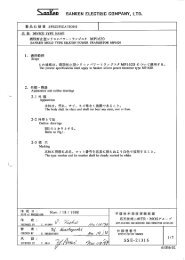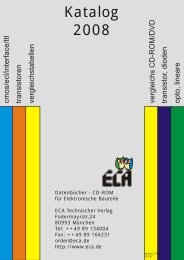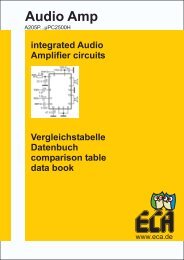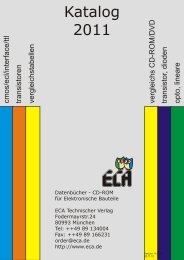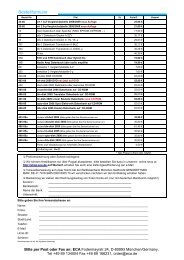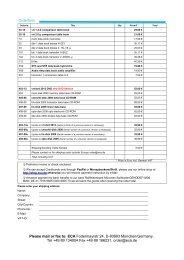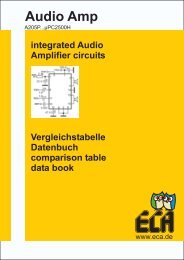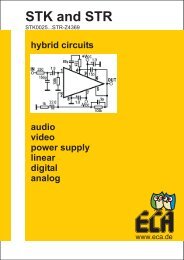EB205 Motorola GaAs Rectifiers Offer High Efficiency in a 1 ... - ECA
EB205 Motorola GaAs Rectifiers Offer High Efficiency in a 1 ... - ECA
EB205 Motorola GaAs Rectifiers Offer High Efficiency in a 1 ... - ECA
Create successful ePaper yourself
Turn your PDF publications into a flip-book with our unique Google optimized e-Paper software.
I<br />
<br />
In order to illustrate the speed of the <strong>GaAs</strong> part, observe the<br />
waveform of Figure 3 (Figure 4 is an expanded portion of<br />
Figure 3). Note the fast recovery, reduced r<strong>in</strong>g<strong>in</strong>g, and low<br />
peak reverse recovery current <strong>GaAs</strong> technology offers. The<br />
actual values of the fast recovery <strong>GaAs</strong> rectifiers are shown <strong>in</strong><br />
Table 3.<br />
At maximum output power, the converter obta<strong>in</strong>ed an<br />
efficiency of close to 93% at a switch<strong>in</strong>g frequency of 1.2 MHz<br />
while the diode recovered <strong>in</strong> 52 nsec at a peak recovery<br />
current of 1.34 amps.<br />
Table 3. Performance <strong>Offer</strong>ed By <strong>GaAs</strong><br />
at 1.29 MHz, 460 Watts<br />
Parameter<br />
Value<br />
Frequency (MHz) = 1.29<br />
Current Slew Rate (Amps/nsec) = –0.0711029<br />
Current Slew Rate (Amps/µsec) = –71.102941<br />
trr (nsec) = 52<br />
Ipk (max) = 10.24<br />
IRMpk (max) = –1.34<br />
<strong>GaAs</strong> rectifiers not only <strong>in</strong>crease converter efficiency, they<br />
also allow operation at switch<strong>in</strong>g frequencies <strong>in</strong> excess of<br />
1 MHz. Figure 5 shows the smooth waveforms of the<br />
converter’s primary side components. The zero voltage<br />
switch<strong>in</strong>g results <strong>in</strong> a smooth dra<strong>in</strong> to source waveform while<br />
the primary current shows how the rectifier’s fast recovery<br />
results <strong>in</strong> low peak stress on the switch<strong>in</strong>g transistors which<br />
enhances the reliability of the converter and reduces<br />
generated EMI.<br />
p (AMPS)<br />
2<br />
1<br />
0<br />
Primary Current and Dra<strong>in</strong> to Source Voltage<br />
IP<br />
VDS<br />
500<br />
400<br />
300<br />
200<br />
VDS (VOLTS)<br />
12<br />
MGR10180 Current<br />
– 1<br />
100<br />
CURRENT<br />
10<br />
8<br />
6<br />
4<br />
– 2<br />
0<br />
1<br />
0<br />
2 3 4<br />
TIME (SECONDS)<br />
Figure 5. <strong>GaAs</strong> Diodes <strong>Offer</strong> Clean<br />
Primary Side Waveforms<br />
CURRENT<br />
2<br />
0<br />
– 2<br />
0<br />
10<br />
8<br />
6<br />
4<br />
2<br />
0<br />
1000<br />
2000<br />
TIME (ns)<br />
3000 4000<br />
Figure 3. <strong>GaAs</strong> <strong>Rectifiers</strong> Produce Very<br />
Clean Waveforms; Even at 1.2 MHz!!<br />
MGR10180 Expanded Current<br />
– 2<br />
1800<br />
1850<br />
1900<br />
TIME (ns)<br />
1950 2000<br />
Figure 4. Performance Advantage <strong>Offer</strong>ed by<br />
<strong>GaAs</strong> <strong>Rectifiers</strong> is Shown <strong>in</strong> This Expanded View<br />
of the Reverse Recovery Current Waveform<br />
SUMMARY<br />
New <strong>GaAs</strong> technology <strong>in</strong> rectifiers allows efficient power<br />
process<strong>in</strong>g at high frequencies. The 180 V platform offered by<br />
<strong>Motorola</strong> can <strong>in</strong>crease power density <strong>in</strong> 48 Vdc<br />
telecommunications and ma<strong>in</strong>frame computer applications.<br />
Densities as high as 90 Watt/cubic <strong>in</strong>ch have been achieved<br />
us<strong>in</strong>g <strong>GaAs</strong> rectifiers. [1] These devices allow designers to<br />
switch converters at 1 MHz without generat<strong>in</strong>g large amounts<br />
of EMI.<br />
ACKNOWLEDGMENTS<br />
The author wishes to thank Mike Horgan of Magnetics Inc.<br />
for his contributions to this design. Mike was responsible for<br />
design<strong>in</strong>g and provid<strong>in</strong>g materials for the power transformer,<br />
<strong>in</strong>ductor and gate drive transformer. Special thanks goes out<br />
to Allen Richter of Kerrigan Lewis who provided all of the Litz<br />
wire for the transformer and Nancy Reynolds of Kemet<br />
Electronics for the tantalum chip capacitors used on the<br />
output. F<strong>in</strong>ally, the efforts of Jeff Morud and Chris Gass of<br />
<strong>Motorola</strong> were greatly appreciated as they proved vital <strong>in</strong><br />
support<strong>in</strong>g the MC34067 IC performance.<br />
4 MOTOROLA



